Grandiflora Rose
Newly formed 1954 a Grandiflora Rose is a cross from a Hybrid Tea with a Floribunda
Photo courtesy of Emmy
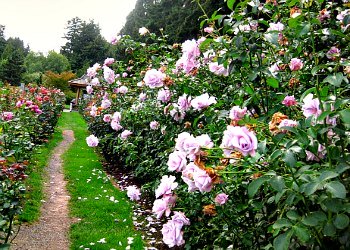
Generally, Grandifloras are tall, vigorous and hardy, produce very large blooms and grow in clusters or trusses, rather than single blooms.
Growing to a height of 5 feet and more, Grandifloras are perfect for cutting and make them a perfect focal point in the garden.
The Queen Elizabeth Rose, named after the young Queen of England, is the most famous Grandiflora rose, which won nearly every international award.
How to Care For Grandiflora Roses
Fertilizing, watering or pruning works are pretty the same as for Hybrid Teas. Grandifloras are hardier than Hybrid teas. Nevertheless they require winter protection in colder climates.
To ensure continual blooming, you have to remove faded flowers.
The section rose care will fully describe all the works you have to perform on Grandifloras.
Some Popular Grandifloras
Grandifloras can be purchased in many colors and sizes. I have listed some of my easy to grow favorites with growing information.
Pink Grandifloras
Queen Elizabeth Rose
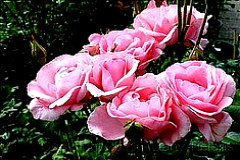
This first and most famous rose is the mother of all Grandifloras. Her clear pink blossoms are moderately fragrant and surrounded by glossy, dark green leaves. They make great cutting roses.
The plant is easy to
grow, winter hardy and grows 5-7 feet high. AARS awarded 1955 and several other
important awards.
Photo courtesy of Moon over Belgium
Tournament of Roses
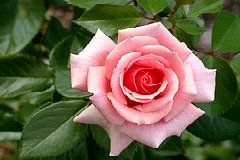
Their light coral pink blooms flower profusely in clusters. The continual blooming rose shows semi-glossy, medium green foliage, is disease-resistant and easy to grow.
The light fragrant flower grows 3-4 feet high and was AARS awarded in 1989.
Photo courtesy of Pavan Gupta
Red Grandifloras
Crimson Bouquet
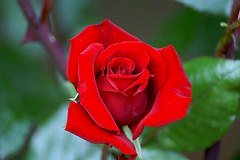
The flowers have velvety red blossoms which mostly grow in clusters. The plant with her deep green foliage is disease resist and one of the most beautiful red roses to grow in your garden.
The rose is AARS awarded in 2000, continually blooming and extremely cold hardy. The Grandiflora grows in zones 4-10 to a height of 4-5 feet.
Photo courtesy of pics ilove
Love
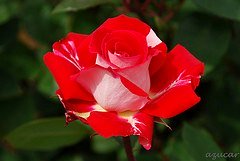
The scarlet red rose with a silvery-white reverse and a light spicy scent is a good cut flower, disease-resistant and grows well in zones 5-9.
AARS awarded in 1980 the plant grows to a height of 3-4 feet.
Photo courtesy of azucargeminis
Orange Grandifloras
New Year
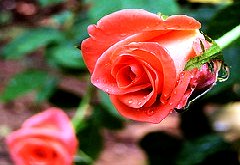
The colorful orange-yellow flowers has a light, fruity fragrance. The inner petals are pale orange, and the outer orange petals show crimson edges.
The plant with glossy, deep green foliage is disease-resistant and was AARS awarded in 1987. The upright, bushy rose grows 3-4 feet tall and grows well in zones 5-10.
Photo courtesy of jowhitaker
Sundowner
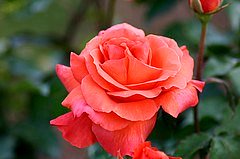
The warm apricot blooms tend to change their color as they mature. The flower is extremely fragrant and blooms all season long, mostly in clusters.
The disease-resistant and hardy plant
sometimes has troubles with powdery mildew in cool, wet climates. AARS awarded, the rose grows 4-7 feet tall and
well in zones 6 and warmer.
Photo courtesy of Ryan Somma
Yellow Grandifloras
Gold Medal
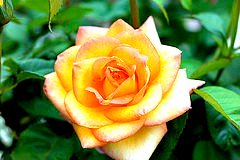
The golden-yellow flowers with slightly red edges have a rich fragrance. The tall, bushy and almost thornless plant shows large, semi-glossy, dark green foliage and is disease resistant.
The flower grows well in zones 6-10 to a height of 4-5 feet and needs winter protection.
Photo courtesy of smthng else
Lavender Grandiflora
Lagerfeld
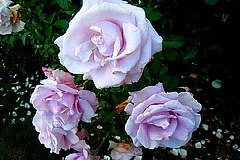
The beautiful lavender colored flowers are excellent fragrant and good for cutting. The rose produces large clusters of blooms and grows 3-5 feet tall.
The flower shows lush, dark green leaves and grows well in zones 6-10 and is disease resistant.
Photo courtesy of fuzzyjay






New! Comments
Have your say about what you just read! Leave me a comment in the box below.